Article's Content
For some people, B2B sales offers the thrill a pro athlete feels right before a big game. For others, B2B sales is the equivalent of going to the dentist the day after Halloween.
No matter which camp you’re in, one thing remains true:
If there’s a way to sell more in B2B, you want to find it. And I’m going to share 5 different ways you can do exactly that.

Here’s what we’re going to cover in this post:
- What B2B sales really is
- Why B2B sales and content marketing are a perfect match
- How to attract potential B2B buyers
- How to convert website visitors into leads
- How to qualify and nurture leads—before you reach out
- How to help your customers fall in love with your product
- How to turn happy customers into promoters
(If you want to jump ahead, now’s your chance!)
What Is B2B Sales?
Business-to-business (B2B) sales is the process of selling a product or service to another business. You could be selling a SaaS product, IT support, office supplies, web app development, or even working as a wholesale supplier —as long as you’re selling from one business to another, it falls under the B2B sales umbrella.

Which leads us to the big question at hand:
How can B2B brands improve their sales process to close more deals (and increase the average revenue per sale) without breaking the bank to do it?
To put that into simpler terms:
How Can B2B Brands Sell More?
I know, I know—everybody is always talking about acquisition.
“Focus all your time on finding new customers, don’t think about anything else, sell more! Boom—mission accomplished!”
Here’s the thing:
When I say “sell more” I’m talking about two things in particular:
- More logos on the customer list (acquire new customers)
- More revenue from each logo (increase revenue per customer)
So it’s not all about acquisition.
If you’re in any sales role at a B2B company—sales manager, head of sales, CEO, etc.—I’ll bet you’re looking for both of those things too.
So what can you actually do to sell more in 2024?
B2B Sales + Content Marketing = A Perfect Match
Here’s the truth:
B2B sales is becoming more and more difficult every year.
According to Demandbase and the 2018 Demand Gen Report, B2B sales cycles are getting longer and more people are getting involved along the way.
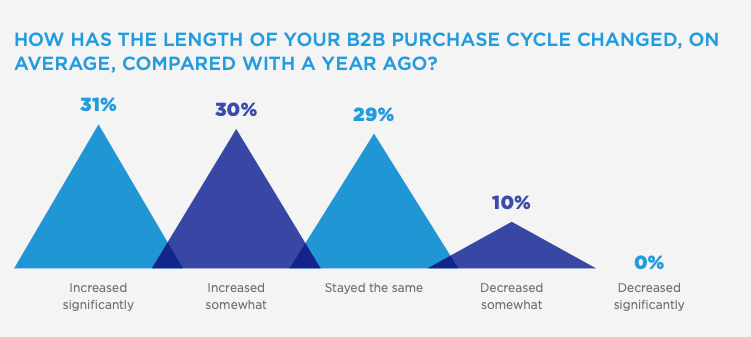
If each sale is demanding more and more time from your B2B salespeople, what can you do to increase sales performance besides just hiring more talent?
The answer:
Double down on content marketing.
Even though the sales funnel has changed a bit within recent years, sales and marketing alignment still remains stronger than what it is thought of.
The same report from Demandbase said B2B buyers are more interested than ever in high quality content:
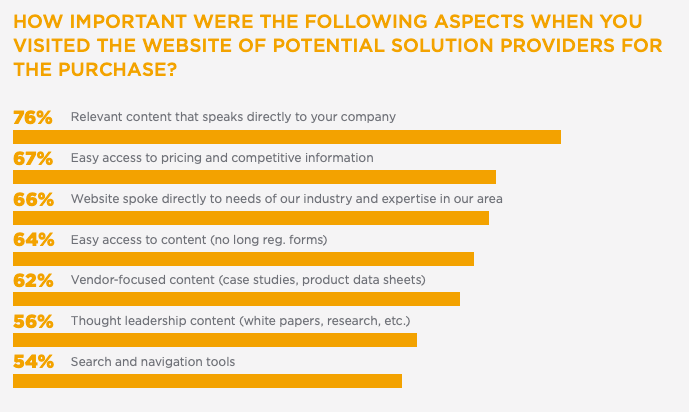
Content marketing strategies even work for companies who focus on product led growth. In fact, content is often needed to get products off the ground when they first launch.
B2B buyers are also spending more time in the research phase than ever before. They’re using more time and other resources to:
- Research the purchase itself
- Evaluate alternative products
- Review purchases before they’re made
- Analyze ROI in-depth
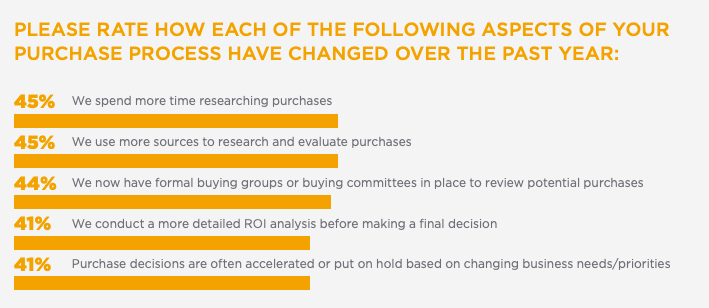
So they’re doing more research, but where is that research happening?
According to BigCommerce, 89% of B2B researchers use the internet in their research process, and they conduct 12 searches before ever reaching out to a single vendor.
Are these just empty statistics on what B2B buyers think they value most?
Nope.
The winning vendor is typically the one who provides the best content, demonstrates thought leadership and industry knowledge, and makes it easy to consume information:
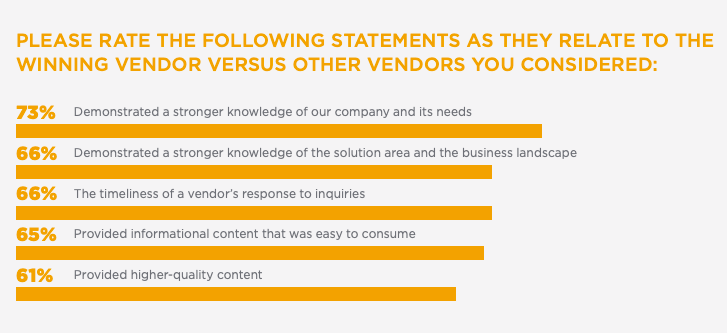
So what does this mean for B2B sales?
If your team is investing in content, your sales process is going to require a lot less legwork along the way. Your buyers are already doing research on their own time. They’re already searching for content to help them decide between you and your competitors.
So when you invest in content…
…YOU can be the one who creates the content they’re searching for.
If they Google “Your Company vs Your Competitor,” wouldn’t you rather be the one who answers their questions?
And with that, let’s jump into the tactical side.
Here are 5 ways you can use content marketing to fill your sales pipeline, close more deals, and turn your customers into promoters:
1. Bring potential buyers to you with top-of-funnel content
Let’s take a look at HubSpot’s inbound marketing model:
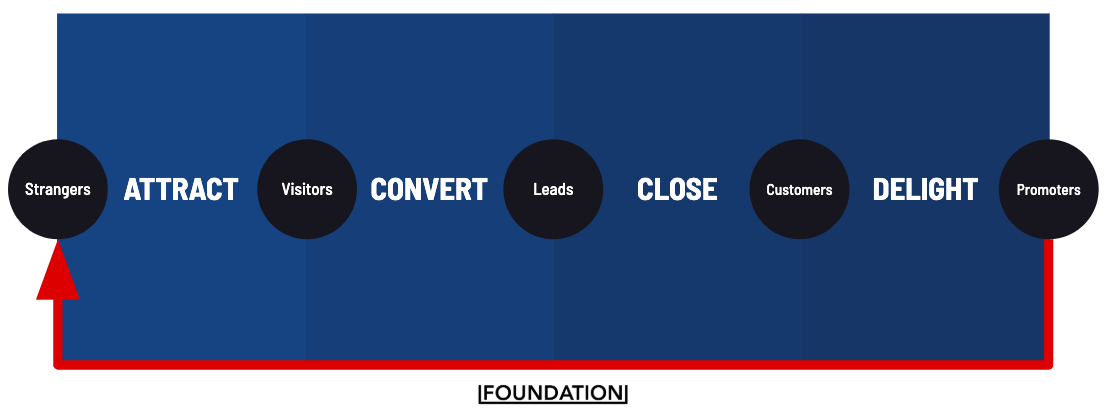
The first thing you need to do when selling a SaaS product is attract strangers who know nothing about you to your website. After you’ve attracted them, you can convert, close and delight.
But question #1 is this:
How do you—a B2B marketer or salesperson—actually attract these people?
(Drumroll please…)

With great content.
The people you’re trying to attract have questions they want answers to, topics they’re interested in, and problems they’re trying to solve.
If you can create content that answers those questions, explains those topics, and solves those problems, you’ll start attracting folks to your website.
But how do you find these questions, topics and problems?
Here are two good places to start:
Keyword research
You can use tools like Ahrefs, Moz and Keywords Everywhere to find the keywords your audience is searching for.
Here’s an example for you:
“SEO best practices” is searched 2,600 times every month in Google. It’s a topic people are actively looking for answers to.
So what did we do?

Figure out what questions your audience is asking, then create content to answer those questions.
Community research
Understanding your audience and what they care about is a crucial step in creating great content.
And one of the best places to learn about that audience of yours is in communities.
Spend some time in relevant Facebook Groups, Quora, popular forums in your industry—wherever your audience is hanging out. Once you know where they’re spending time, you’ll be able to bring in the right kind of traffic to your site.
Look for popular topics and questions. If a lot of people are asking the same question or following a particular thread, then there’s clearly an appetite for that topic.
Back to the SEO best practices example…
We noticed that this Quora question has 100+ followers:
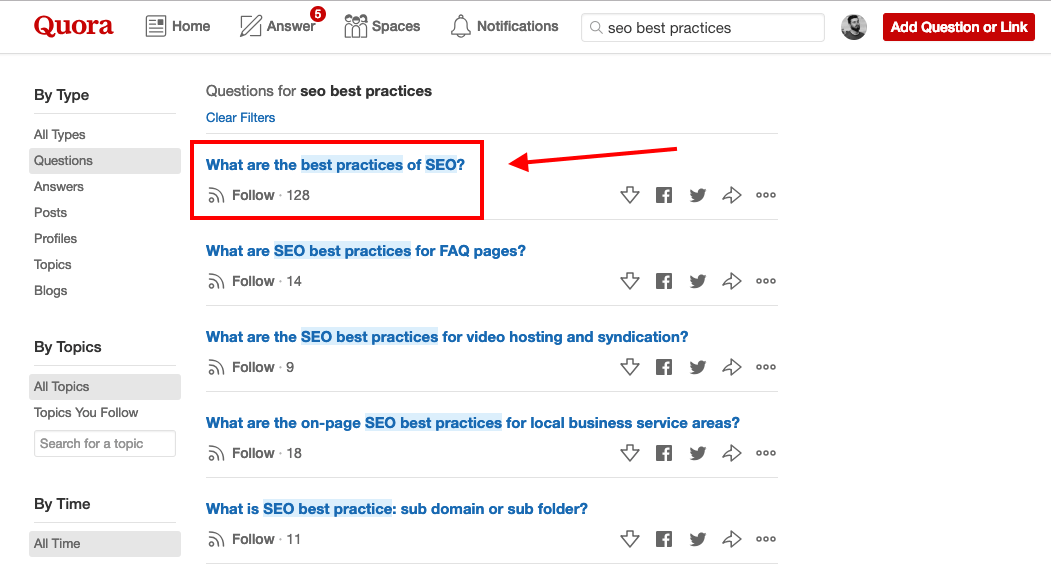
That means over 100 Quora users want to see answers to that question.
And if we create a blog post on the subject, we can share the key takeaways directly in Quora to attract even more traffic to our post.
Here’s your key takeaway:
More traffic → More leads → More sales.
The more qualified visitors you can attract to your website, the more opportunities you’ll have to fill your pipeline with qualified leads.
2. Use calls-to-action in your content
So you’re generating more traffic using some of the tactics above.
You’re creating content your audience is searching for, implementing some SEO best practices for B2B brands (see what we did there?) and getting your content in front of the right people—and your traffic is climbing.
That’s great!
But if your goal is to make more sales, what’s next?
Converting visitors into leads, of course.
Let’s jump back to the inbound marketing model:

We’ve attracted visitors, so we’re officially entering the Convert stage. We need to find a way to convert this traffic into leads.
How do you that?
By putting calls-to-actions in your content.
Just like CoSchedule does here:
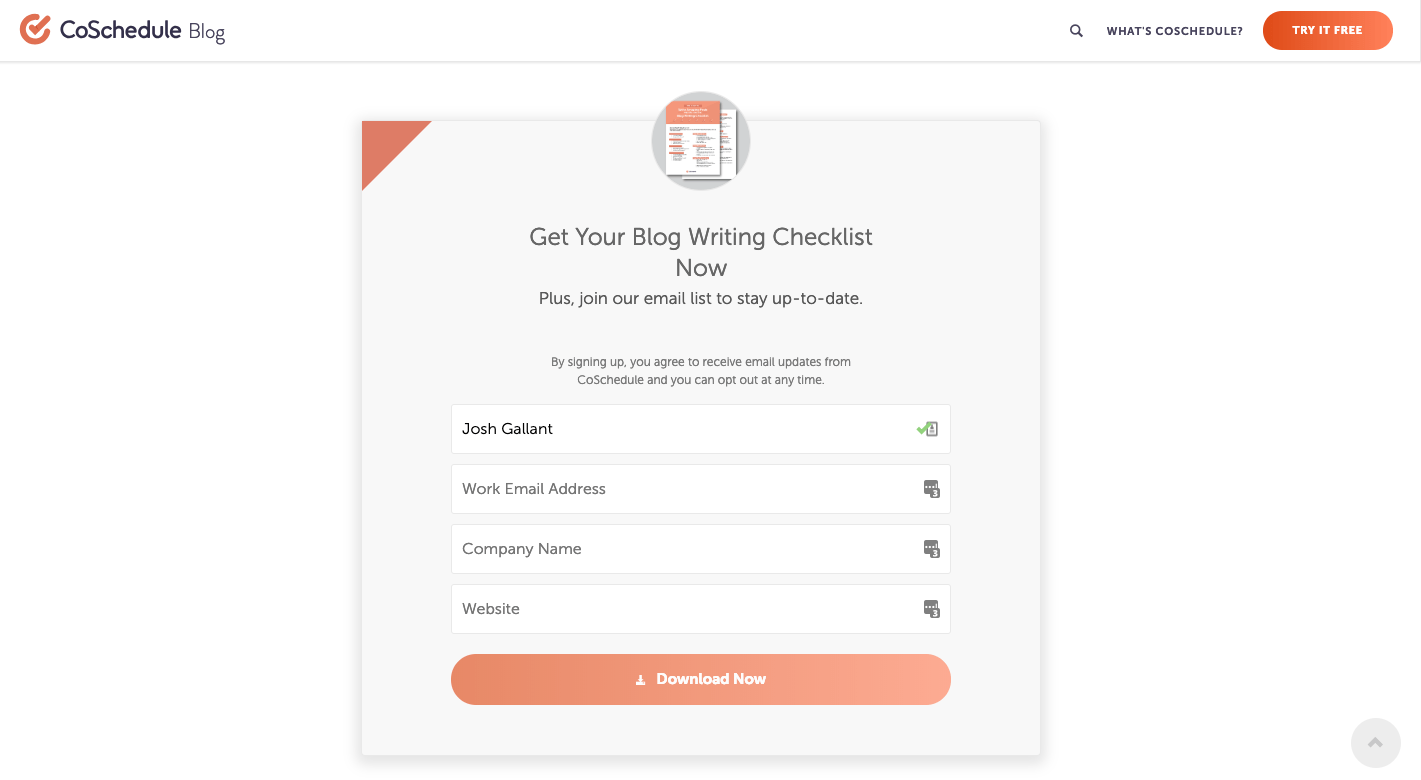
And Proposify in this blog post:
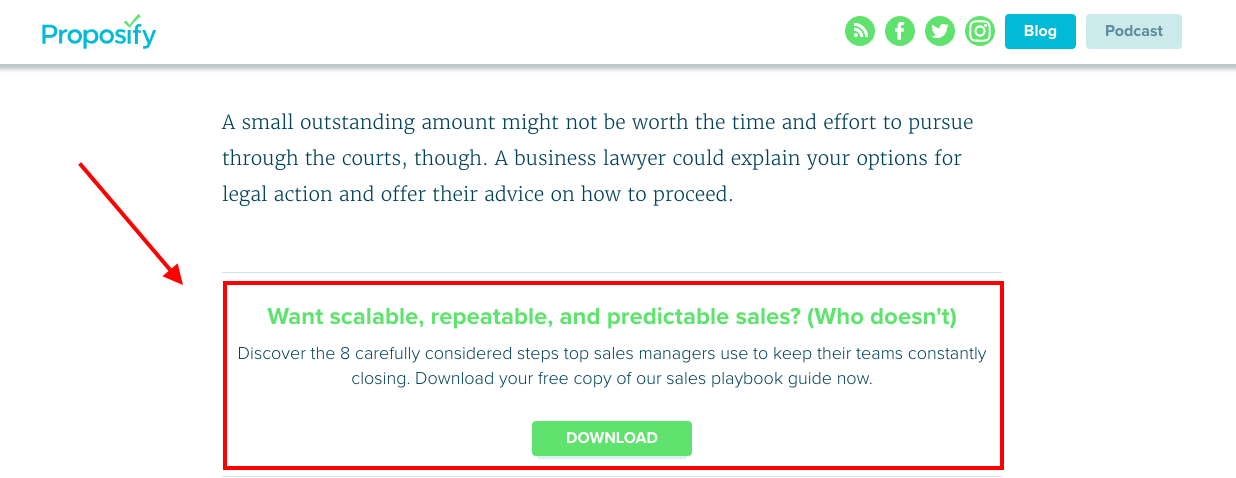
These pages are generating traffic.
And that’s a great first step!
But until you convert that traffic into leads, it won’t do an awful lot to help your business accomplish its goals—which in your case is more sales.
The key takeaway here is this:
Whenever you create a piece of content to attract visitors to your site, make sure you include calls-to-action that will inspire your visitors to do something.
Download a free checklist…
Request a product demo…
Start a free trial…
Download a case study…
Whatever action you want visitors to take, your content should be designed to convert them into leads. You can find 9 different B2B lead generation tactics to start with right here:
3. Qualify & nurture leads with bottom-of-funnel content
So you’re getting great traffic and the pipeline is filling up quick.
Awesome—what’s next?
Should you send every lead straight to your sales pipeline CRM to contact?
You could, but…
As you scale up your inbound marketing efforts and attract more traffic and leads, your sales team is going to be spending A LOT of valuable time reaching out to leads that may or may not be qualified.
Here’s the solution:
Create more high-level, conversion-focused content that you can automatically share with leads after they give you their contact information.
Close.com (a CRM tool) does this perfectly:
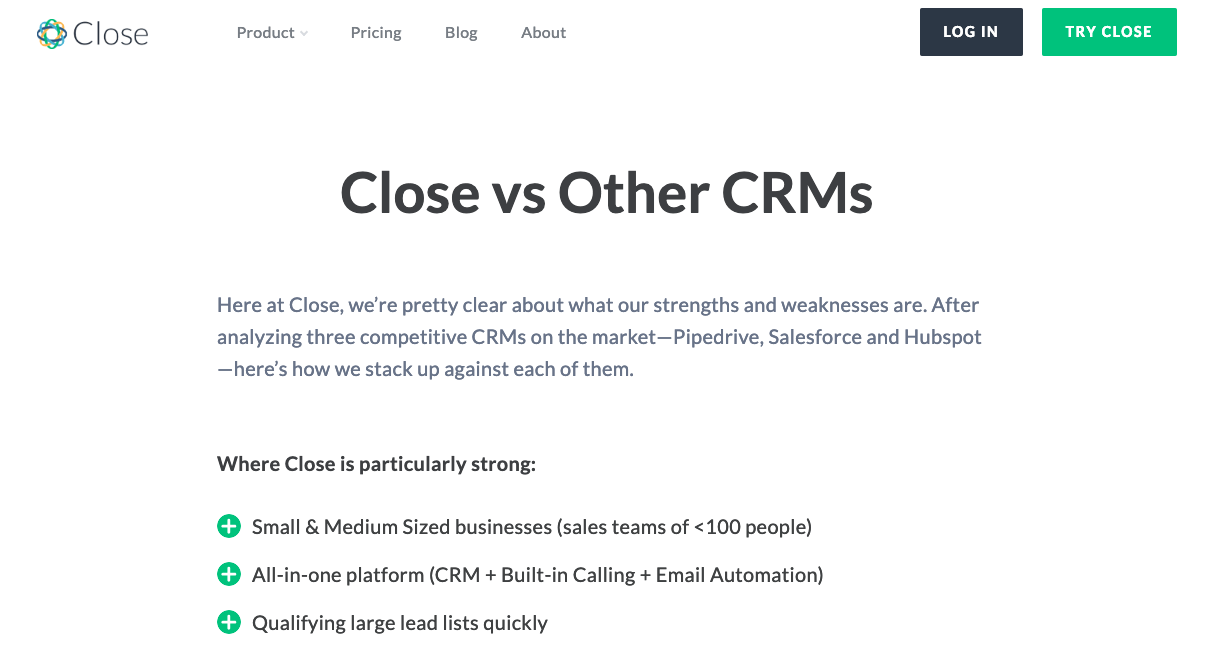
When someone downloads a free resource through their blog and becomes a lead, the first thing Close.com sales team wants to know is whether that person is actually interested in a new CRM.
If the answer is no, then there’s no reason for their sales team to spend time talking to that lead right now.
But how can the sales team figure out what that lead’s intentions are without talking to them, apart from training, sales coaching software, and effective onboarding?
Using bottom-of-funnel content like comparison pages.
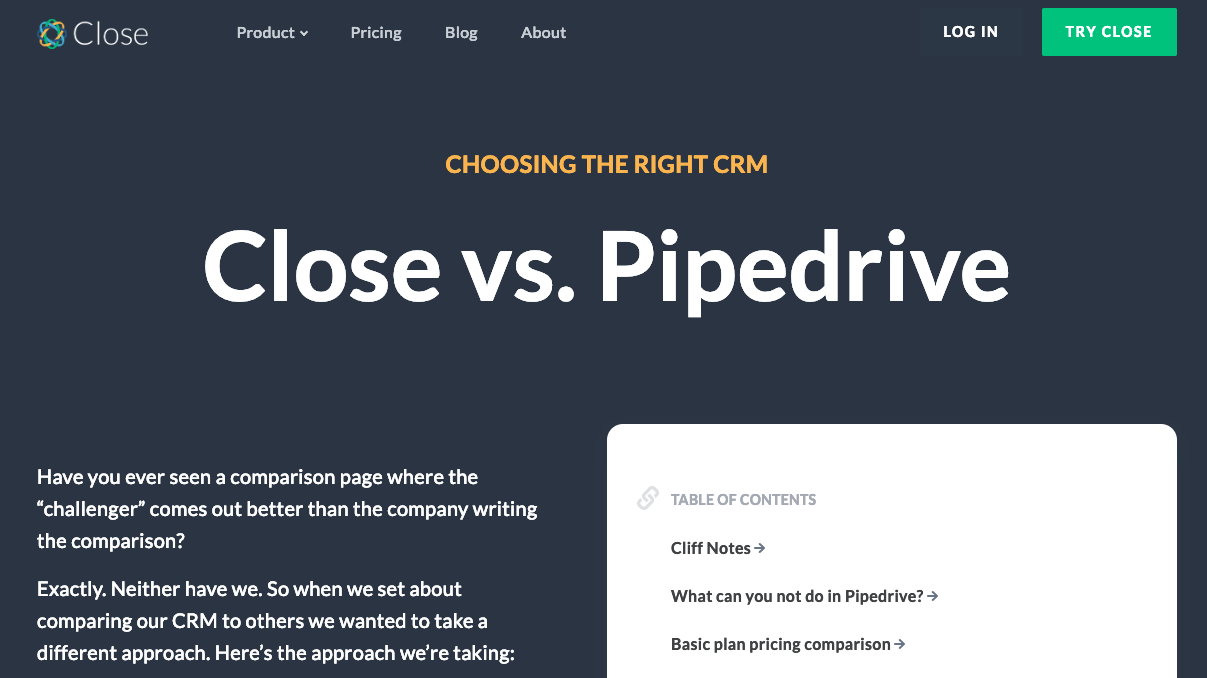
Who is most likely to look at a page comparing rival CRMs?
Someone who’s interested in buying & wants to find the best CRM software, of course.
So Close sets up an automated email sequence that shares their comparison content with new leads after they opt in. If a lead clicks through and spends time on the page, then sales is notified that this lead is worth reaching out to.
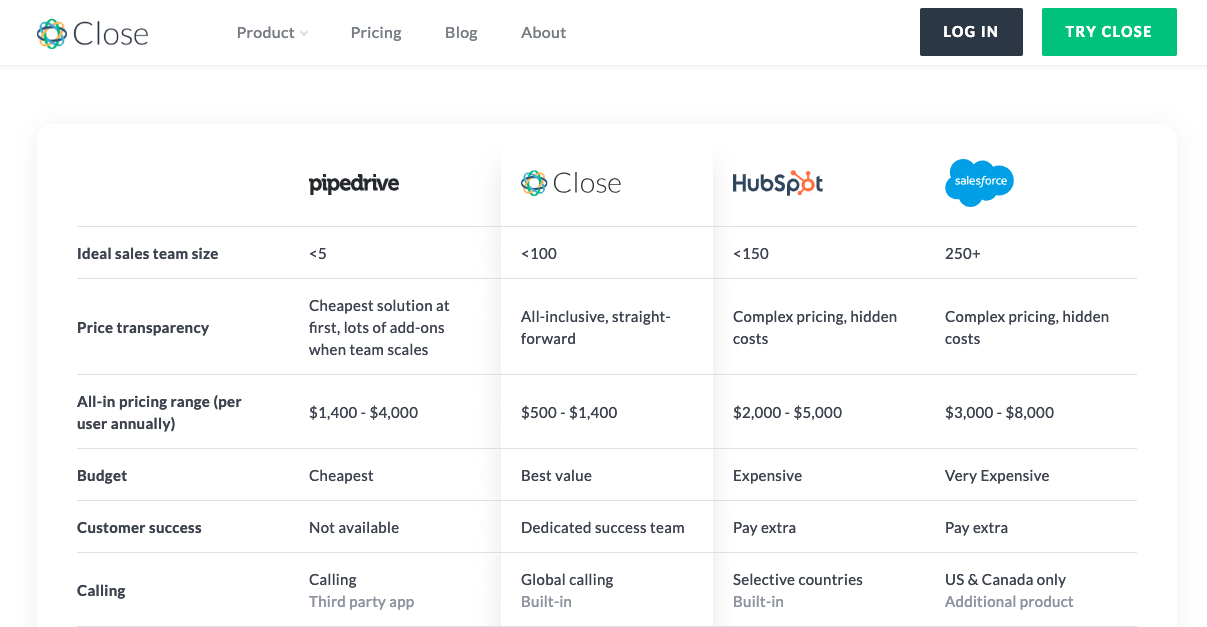
And it doesn’t have to be all automated—your sales team can also use bottom-of-funnel content like this to nurture leads on their own.
When a lead researches alternatives, your sales assistants can share this comparison content to help control the narrative about which solution is best for that prospective buyer (and they’ll save precious time in the process).
Since the average cost of an in-house SDR is over $6,000 per month, saving that precious time can directly lead to you getting more value out of your SDRs.
Keep this in mind:
Without bottom-of-funnel content, your sales team has to do all the heavy lifting with every lead that finds their way into your system. Create content that can be used to qualify leads before you even reach out.
4. Help customers use your product
I know what you’re probably thinking right now…
“Help customers use the product? That’s the customer success team’s job!”
Maybe, but let’s look at it through a B2B sales lens:
Not too long ago, the folks at Ahrefs—a SaaS product for understanding all things SEO (we’re big fans of Ahrefs)—launched a new version of their site audit feature:
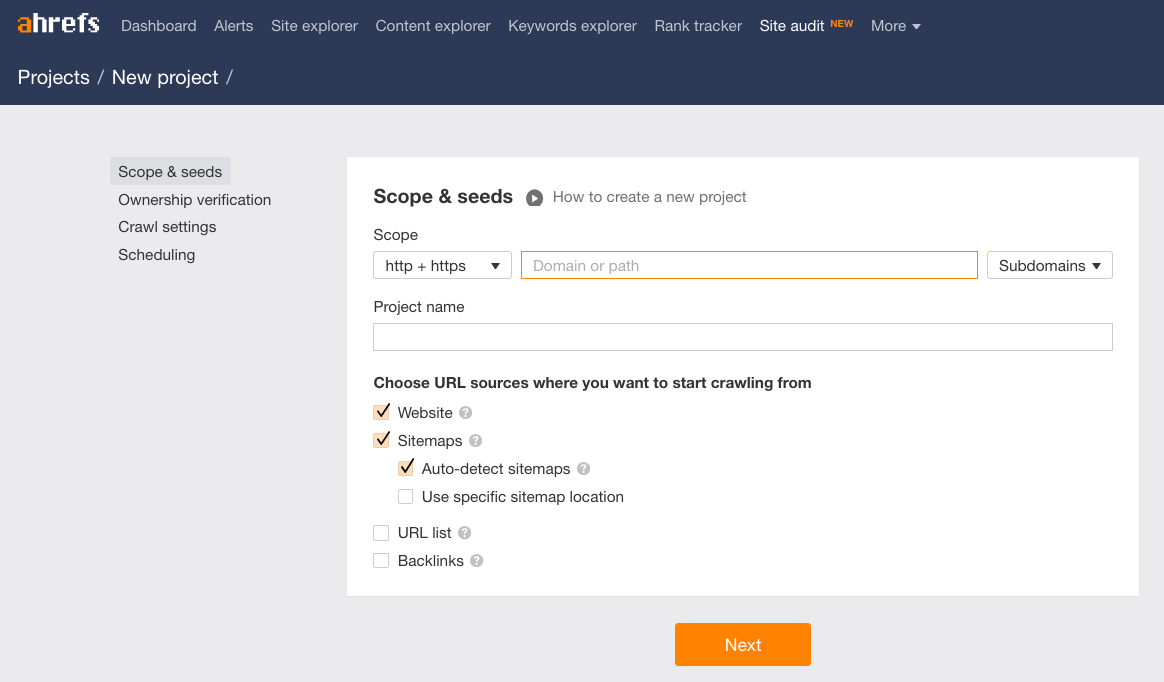
It’s incredibly helpful, but there’s a bit of a learning curve.
Will the more tech-savvy Ahrefs users figure it out on their own?
Most likely—and that’s perfectly fine!
But what about Ahrefs users who aren’t up to speed on the technical side of SEO but still want to take advantage of the new feature announcement?
They’re looking at that “New project” screen wondering what scope and seeds are, which boxes should they check…
So what did Ahrefs do?
They did this:
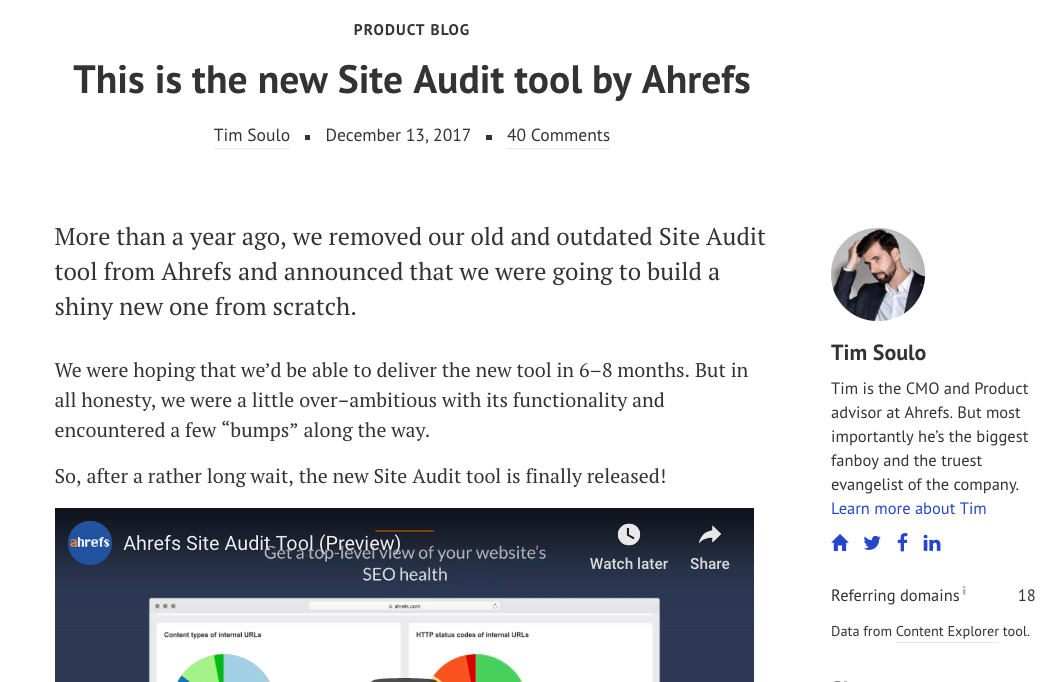
Instead of just shipping the new and improved site audit feature and calling it a day, Ahrefs CMO Tim Soulo published a complete guide on how to use the new tool.
Again—what does this have to do with B2B sales?
Here’s your answer:
Ahrefs armed their existing customers with the know-how to painlessly use the product and see awesome results.
The more those customers love using the product, the more they’re going to use it (obvious, yes).
And the more they use it, the more likely they are to keep renewing their subscription or even upgrade to a plan with higher usage limits.
Boom!
Just like that, the company increases their chances of keeping customers around and increases their revenue per customer—all by investing in content that helps their users.
Key takeaway:
Don’t spend all your time creating content to attract leads while ignoring your existing customers.
If they’re not using your product to its full potential, they won’t feel like they’re getting the value they paid for. If they don’t think your product has enough value, the likelihood of churn will be sky-high.
Helping your customers succeed helps you succeed as well.

5. Turn customers into promoters
So you’re attracting traffic to your website, converting that traffic into leads, qualifying and closing those leads, and setting your customers up for success.
What else is there to do?
Here’s your answer:
Turn happy customers into your very own team of promoters.
Just like Ben S. here, who’s raving about Ahrefs on G2 Crowd.
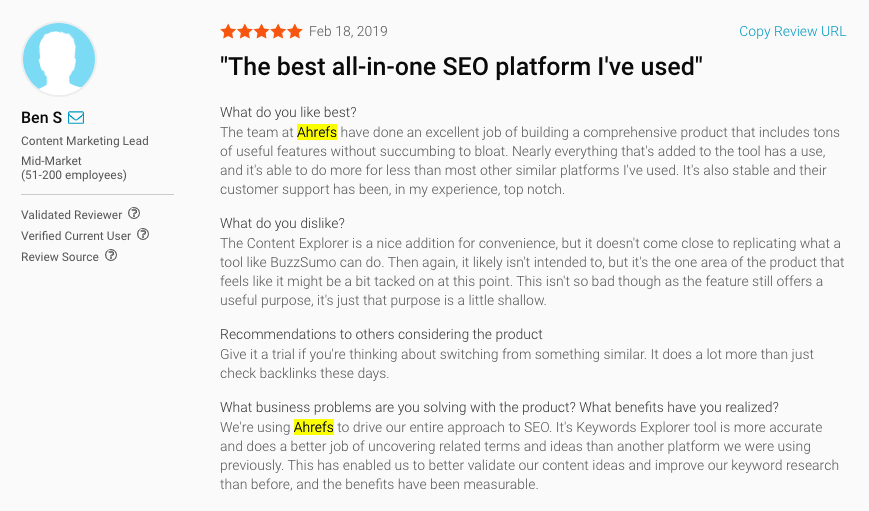
The Yelpification of B2B is real.
Just as you check Yelp to see what people think of a new restaurant before you make a reservation, B2B buyers look to reviews, testimonials and case studies to see what their peers think before they buy your product.
If the reviews are positive, your chances of closing that potential buyer climb.
Quick question for you:
If there was a way to make your customers so happy that they went out of their way to write glowing reviews, would you want to do it?
(I know—obviously the answer is yes.)
Well I have some good news:
There is a way—and you’re already well on your way to doing it.
Here’s how you turn customers into promoters:
- Have an awesome product (like Ahrefs)
- Have an awesome support team (also like Ahrefs, as Ben S. mentioned)
- Create content that helps your customers use your product
- Create content that provides overall value to customers
And #4 is the big one for your content marketing strategy.
If you have a great product, a great support team, and great how-to’s and product onboarding content, the next thing you need to do is to think outside your product.
Create content that genuinely helps your audience—even if it isn’t directly related to using your product.
For example, Venngage has a YouTube channel full of helpful content:
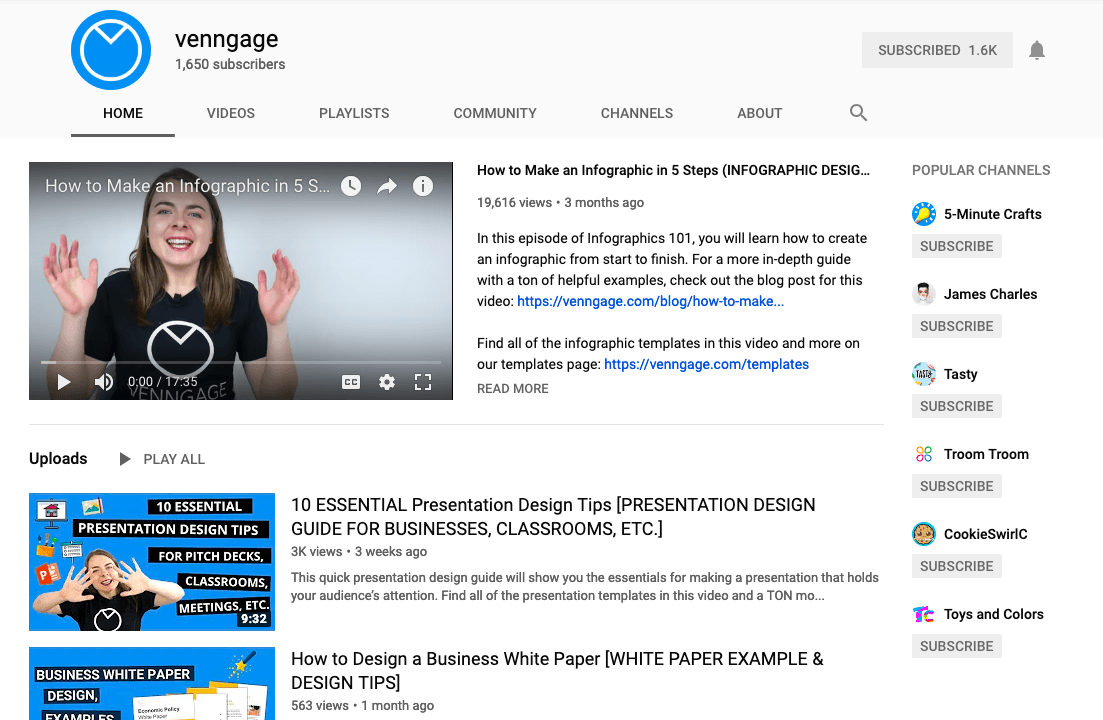
And Buffer is constantly creating valuable content:
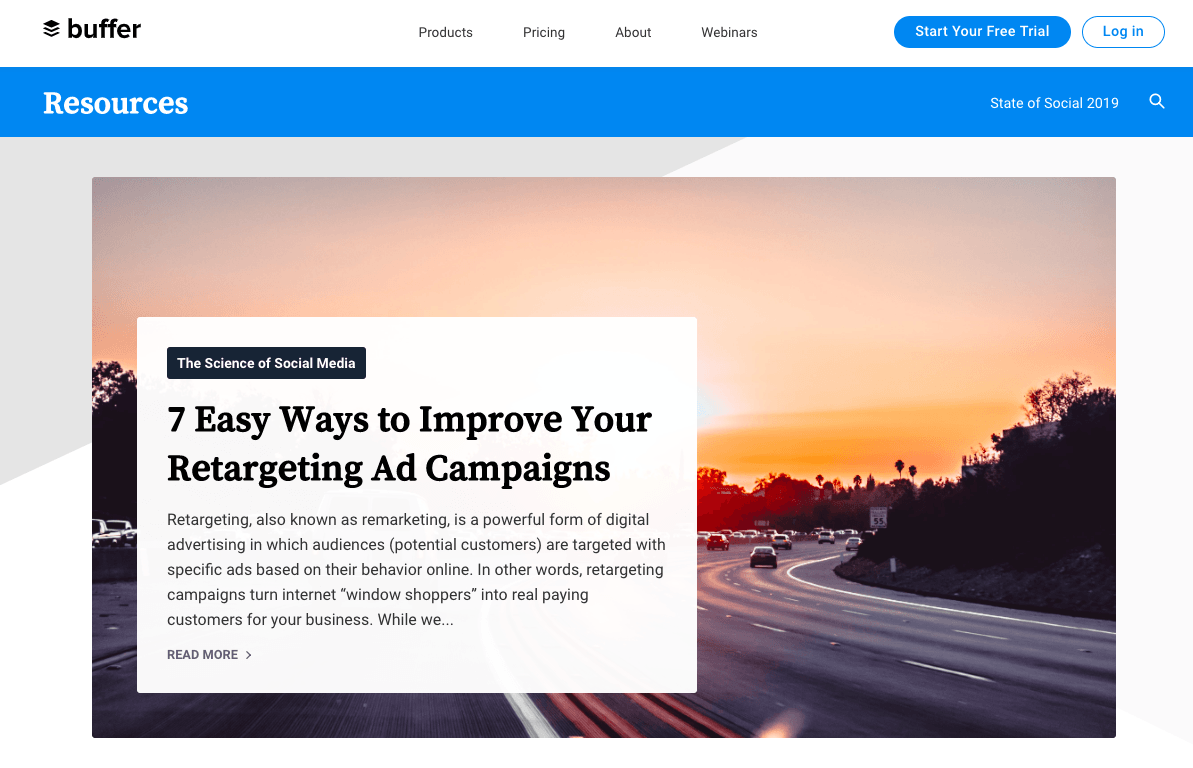
You can’t manage ad campaigns in Buffer, so this post isn’t a product tutorial. It’s entirely focused on helping customers—current and future—succeed with their marketing.
The concept here is simple:
If your audience sees you as a provider of value outside of the product they’re paying for, their perception of you is going to be positive.
And they’re going to share reviews like this:
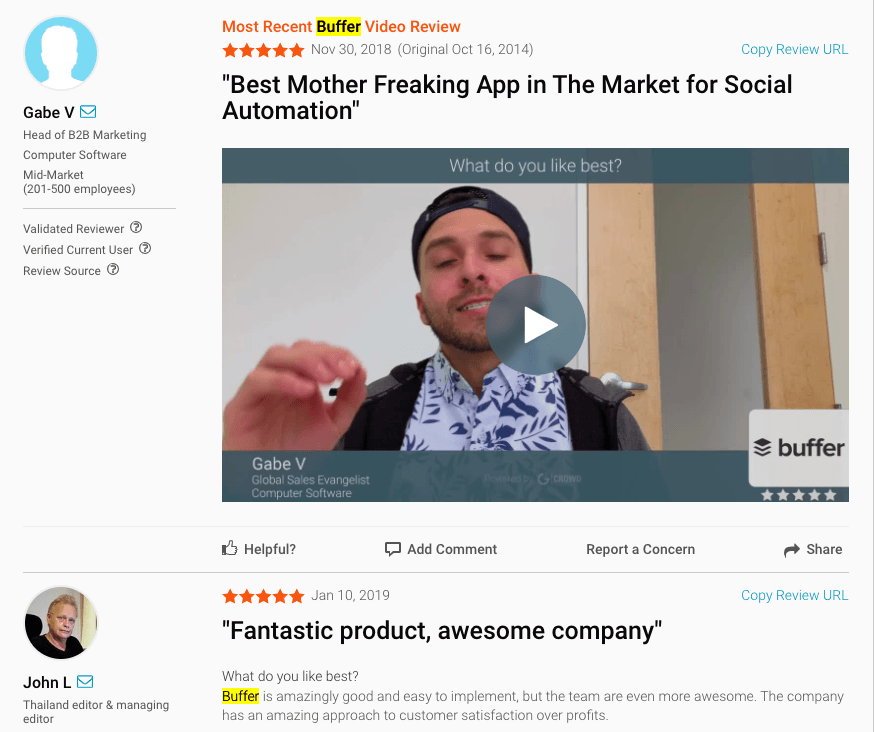
Now Over To You
The verdict is in:
If you want to up your B2B sales numbers this year, then it’s time to invest in content marketing that will grow your website, fill your sales pipeline, close more deals and convert happy customers into really happy promoters.
Let’s recap the 5 ways you can use content marketing to sell more in B2B this year:
- Bring potential buyers to you with top-of-funnel content
- Use calls-to-action in your content
- Qualify and nurture leads with bottom-of-funnel content
- Help customers use your product
- Turn customers into promoters
How have you used content marketing to sell more in B2B?
Let me know what you think on X (formerly known as Twitter)@JoshGallantco!







